A Study of Flexi-Time in International Banking: Pros and Cons
VerifiedAdded on 2023/03/29
|16
|3491
|89
Report
AI Summary
This report provides a comprehensive analysis of flexi-time practices in international banks. It begins with an executive summary outlining the paper's objective to analyze flexible working hours, exploring international practices, and evaluating the advantages and disadvantages of flexi-time. The introduction defines flexi-time and its role in enhancing work efficiency and employee satisfaction, highlighting its benefits for employees and banks. The discussion section delves into best practices across Europe, the United States, and Australia, examining how different banks implement flexible work arrangements. The report then thoroughly examines the pros and cons of flexi-time, including increased worker productivity, improved work-life balance, and reduced costs, while also addressing challenges such as potential misuse and difficulties in supervision. The report also discusses how flexi-time can impact various departments within banks and concludes by emphasizing the importance of flexi-time in contributing to smoother work operations.
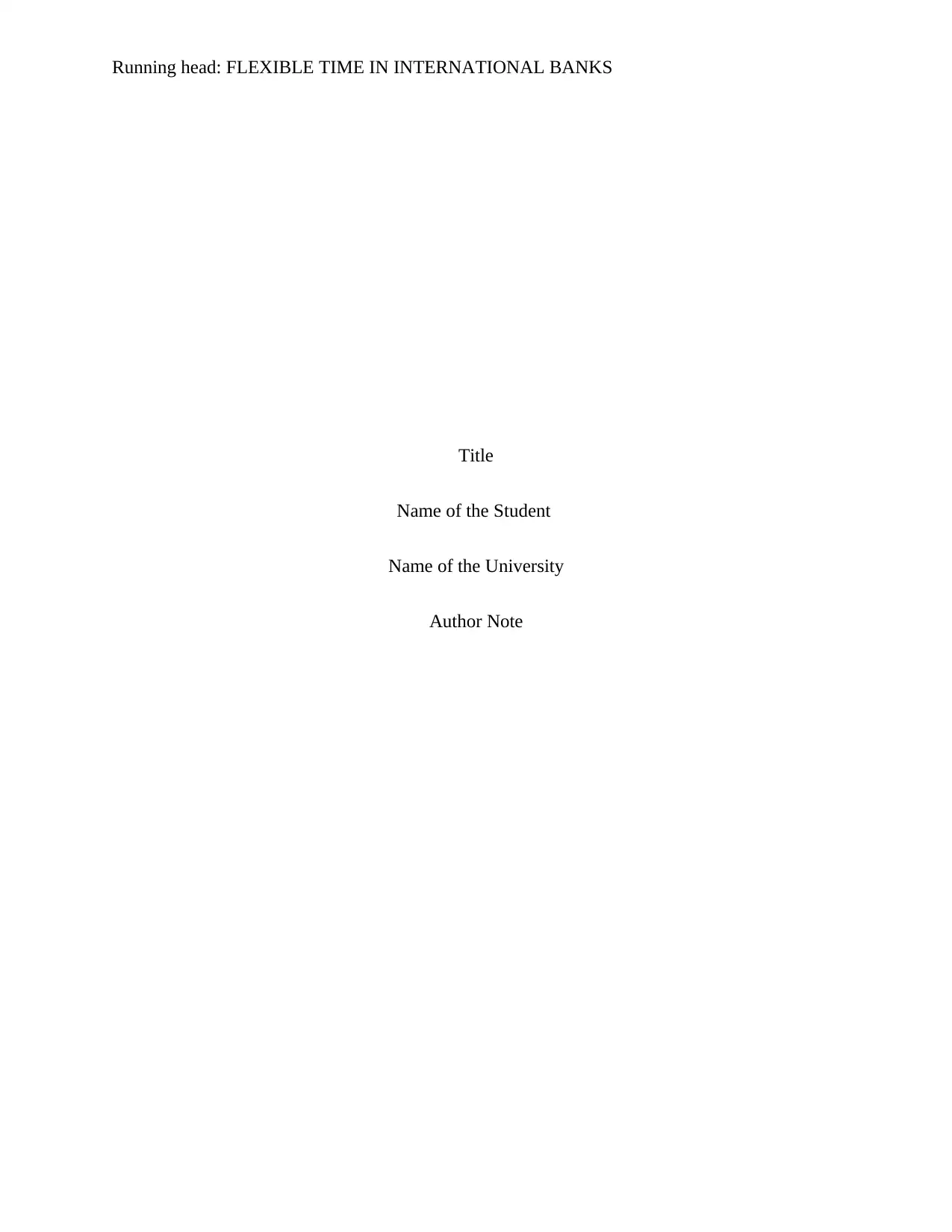
Running head: FLEXIBLE TIME IN INTERNATIONAL BANKS
Title
Name of the Student
Name of the University
Author Note
Title
Name of the Student
Name of the University
Author Note
Paraphrase This Document
Need a fresh take? Get an instant paraphrase of this document with our AI Paraphraser
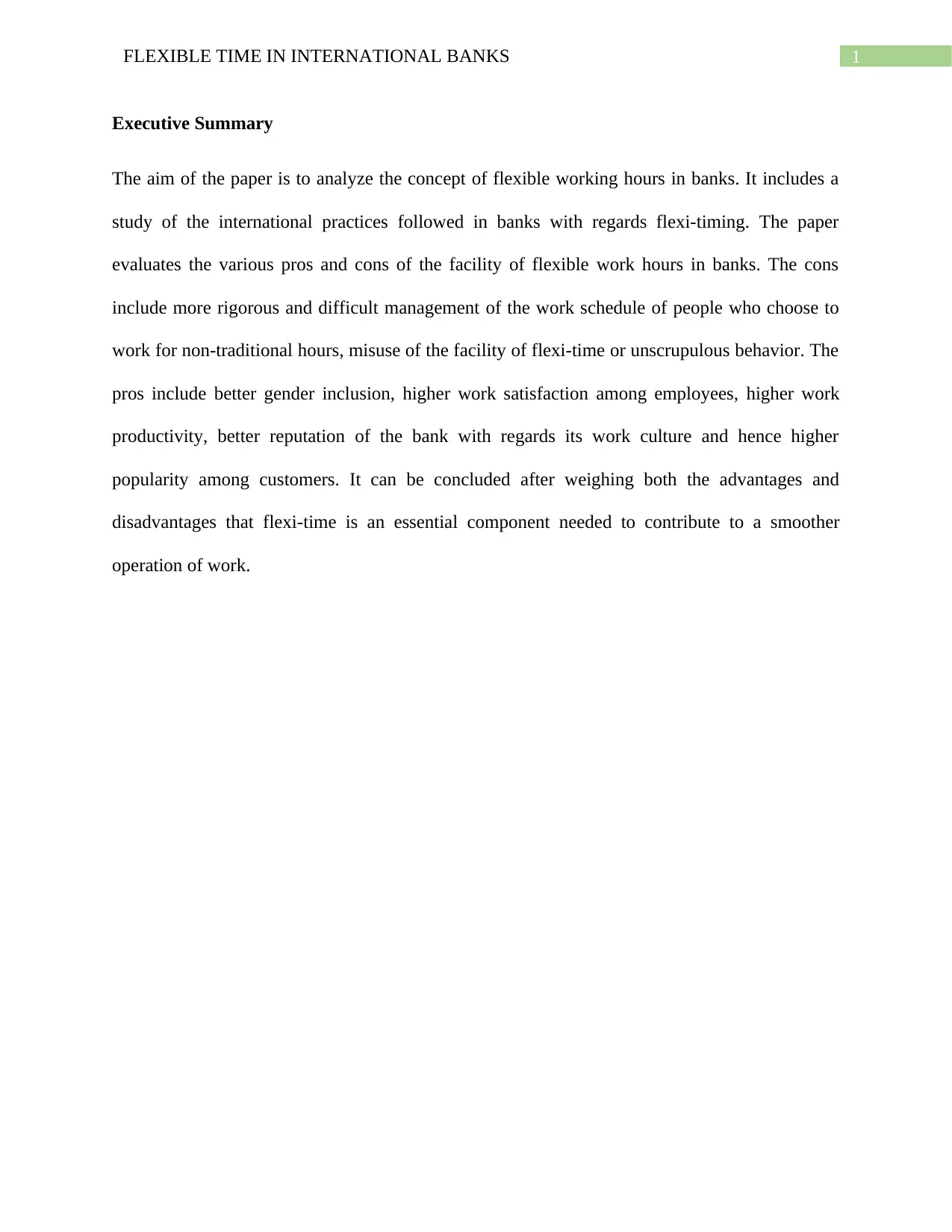
1FLEXIBLE TIME IN INTERNATIONAL BANKS
Executive Summary
The aim of the paper is to analyze the concept of flexible working hours in banks. It includes a
study of the international practices followed in banks with regards flexi-timing. The paper
evaluates the various pros and cons of the facility of flexible work hours in banks. The cons
include more rigorous and difficult management of the work schedule of people who choose to
work for non-traditional hours, misuse of the facility of flexi-time or unscrupulous behavior. The
pros include better gender inclusion, higher work satisfaction among employees, higher work
productivity, better reputation of the bank with regards its work culture and hence higher
popularity among customers. It can be concluded after weighing both the advantages and
disadvantages that flexi-time is an essential component needed to contribute to a smoother
operation of work.
Executive Summary
The aim of the paper is to analyze the concept of flexible working hours in banks. It includes a
study of the international practices followed in banks with regards flexi-timing. The paper
evaluates the various pros and cons of the facility of flexible work hours in banks. The cons
include more rigorous and difficult management of the work schedule of people who choose to
work for non-traditional hours, misuse of the facility of flexi-time or unscrupulous behavior. The
pros include better gender inclusion, higher work satisfaction among employees, higher work
productivity, better reputation of the bank with regards its work culture and hence higher
popularity among customers. It can be concluded after weighing both the advantages and
disadvantages that flexi-time is an essential component needed to contribute to a smoother
operation of work.
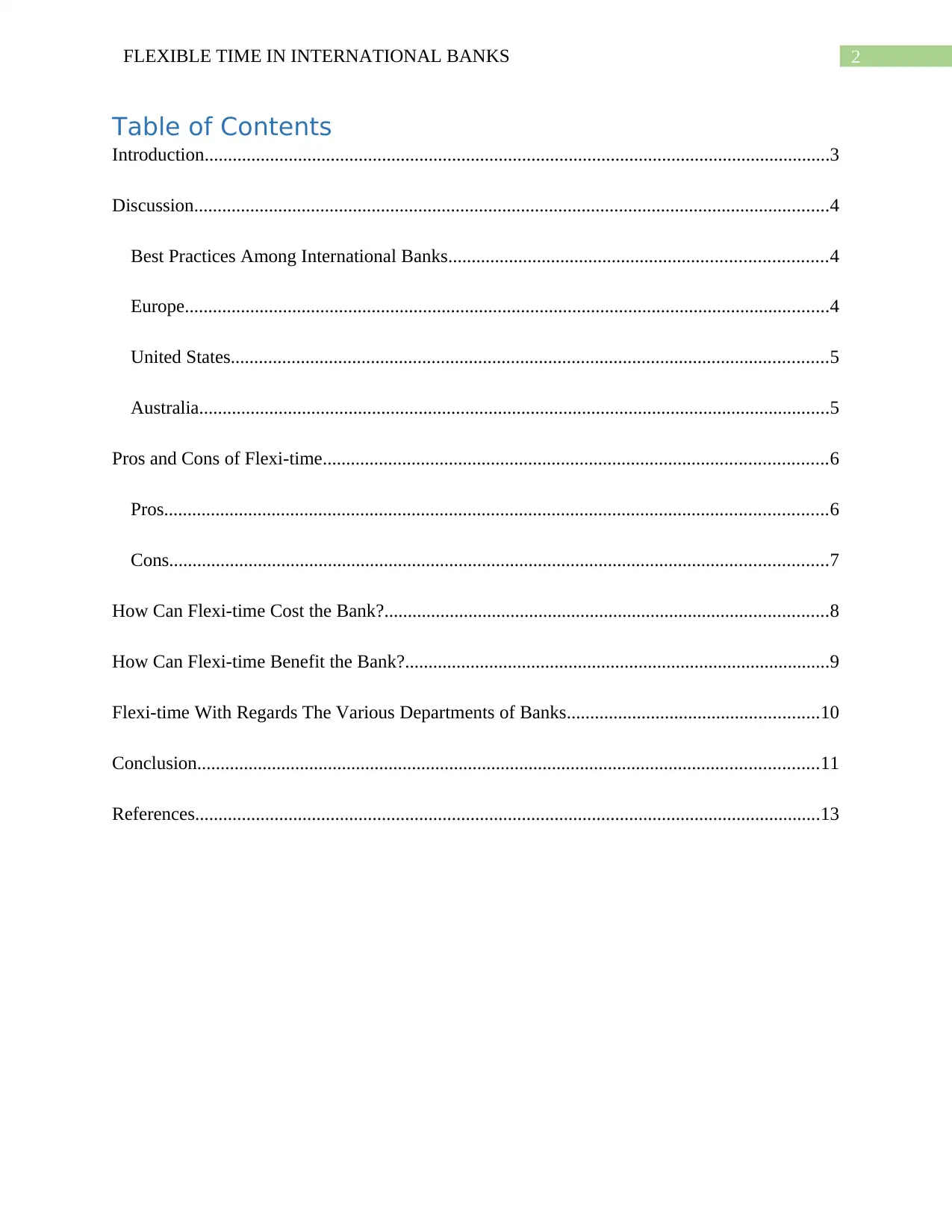
2FLEXIBLE TIME IN INTERNATIONAL BANKS
Table of Contents
Introduction......................................................................................................................................3
Discussion........................................................................................................................................4
Best Practices Among International Banks.................................................................................4
Europe..........................................................................................................................................4
United States................................................................................................................................5
Australia.......................................................................................................................................5
Pros and Cons of Flexi-time............................................................................................................6
Pros..............................................................................................................................................6
Cons.............................................................................................................................................7
How Can Flexi-time Cost the Bank?...............................................................................................8
How Can Flexi-time Benefit the Bank?...........................................................................................9
Flexi-time With Regards The Various Departments of Banks......................................................10
Conclusion.....................................................................................................................................11
References......................................................................................................................................13
Table of Contents
Introduction......................................................................................................................................3
Discussion........................................................................................................................................4
Best Practices Among International Banks.................................................................................4
Europe..........................................................................................................................................4
United States................................................................................................................................5
Australia.......................................................................................................................................5
Pros and Cons of Flexi-time............................................................................................................6
Pros..............................................................................................................................................6
Cons.............................................................................................................................................7
How Can Flexi-time Cost the Bank?...............................................................................................8
How Can Flexi-time Benefit the Bank?...........................................................................................9
Flexi-time With Regards The Various Departments of Banks......................................................10
Conclusion.....................................................................................................................................11
References......................................................................................................................................13
⊘ This is a preview!⊘
Do you want full access?
Subscribe today to unlock all pages.

Trusted by 1+ million students worldwide
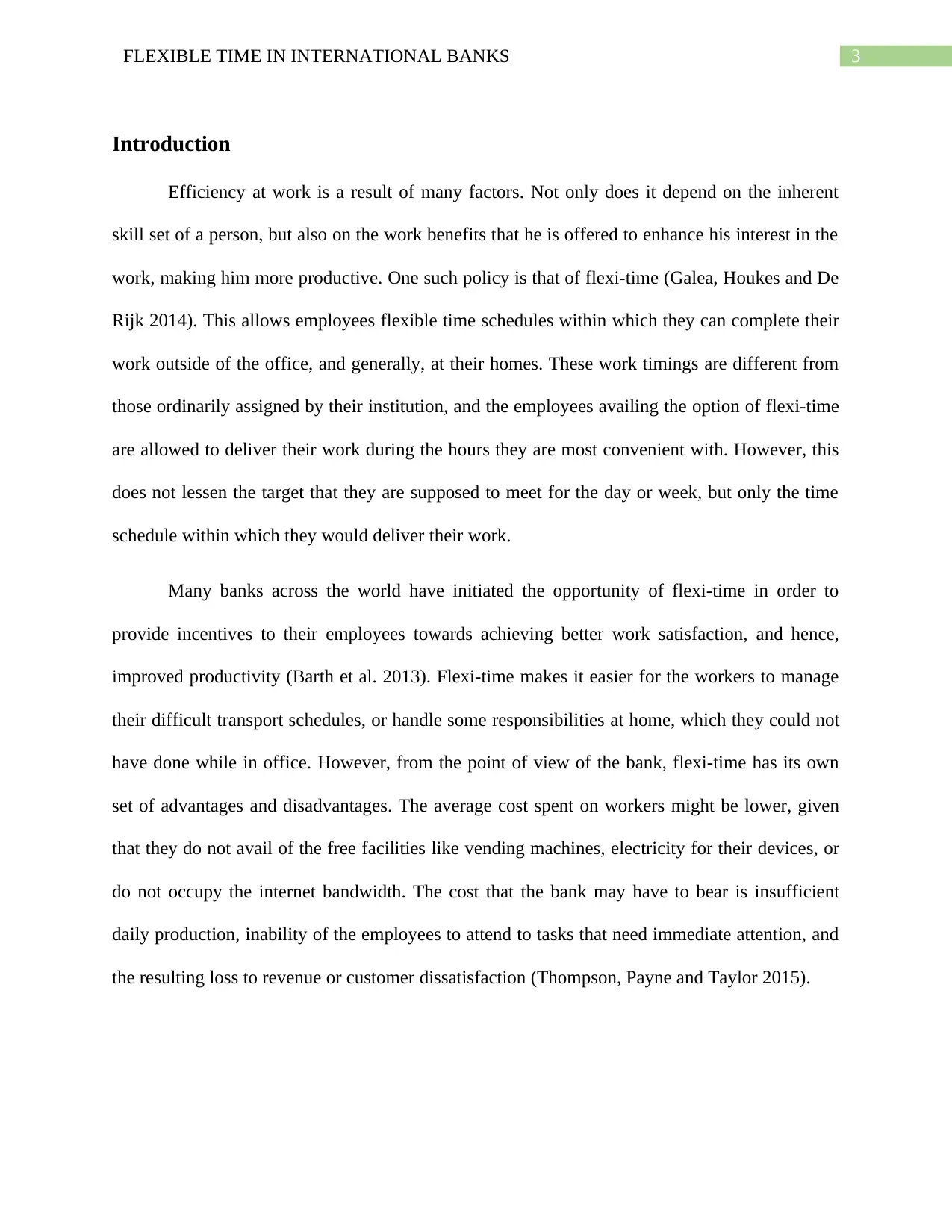
3FLEXIBLE TIME IN INTERNATIONAL BANKS
Introduction
Efficiency at work is a result of many factors. Not only does it depend on the inherent
skill set of a person, but also on the work benefits that he is offered to enhance his interest in the
work, making him more productive. One such policy is that of flexi-time (Galea, Houkes and De
Rijk 2014). This allows employees flexible time schedules within which they can complete their
work outside of the office, and generally, at their homes. These work timings are different from
those ordinarily assigned by their institution, and the employees availing the option of flexi-time
are allowed to deliver their work during the hours they are most convenient with. However, this
does not lessen the target that they are supposed to meet for the day or week, but only the time
schedule within which they would deliver their work.
Many banks across the world have initiated the opportunity of flexi-time in order to
provide incentives to their employees towards achieving better work satisfaction, and hence,
improved productivity (Barth et al. 2013). Flexi-time makes it easier for the workers to manage
their difficult transport schedules, or handle some responsibilities at home, which they could not
have done while in office. However, from the point of view of the bank, flexi-time has its own
set of advantages and disadvantages. The average cost spent on workers might be lower, given
that they do not avail of the free facilities like vending machines, electricity for their devices, or
do not occupy the internet bandwidth. The cost that the bank may have to bear is insufficient
daily production, inability of the employees to attend to tasks that need immediate attention, and
the resulting loss to revenue or customer dissatisfaction (Thompson, Payne and Taylor 2015).
Introduction
Efficiency at work is a result of many factors. Not only does it depend on the inherent
skill set of a person, but also on the work benefits that he is offered to enhance his interest in the
work, making him more productive. One such policy is that of flexi-time (Galea, Houkes and De
Rijk 2014). This allows employees flexible time schedules within which they can complete their
work outside of the office, and generally, at their homes. These work timings are different from
those ordinarily assigned by their institution, and the employees availing the option of flexi-time
are allowed to deliver their work during the hours they are most convenient with. However, this
does not lessen the target that they are supposed to meet for the day or week, but only the time
schedule within which they would deliver their work.
Many banks across the world have initiated the opportunity of flexi-time in order to
provide incentives to their employees towards achieving better work satisfaction, and hence,
improved productivity (Barth et al. 2013). Flexi-time makes it easier for the workers to manage
their difficult transport schedules, or handle some responsibilities at home, which they could not
have done while in office. However, from the point of view of the bank, flexi-time has its own
set of advantages and disadvantages. The average cost spent on workers might be lower, given
that they do not avail of the free facilities like vending machines, electricity for their devices, or
do not occupy the internet bandwidth. The cost that the bank may have to bear is insufficient
daily production, inability of the employees to attend to tasks that need immediate attention, and
the resulting loss to revenue or customer dissatisfaction (Thompson, Payne and Taylor 2015).
Paraphrase This Document
Need a fresh take? Get an instant paraphrase of this document with our AI Paraphraser
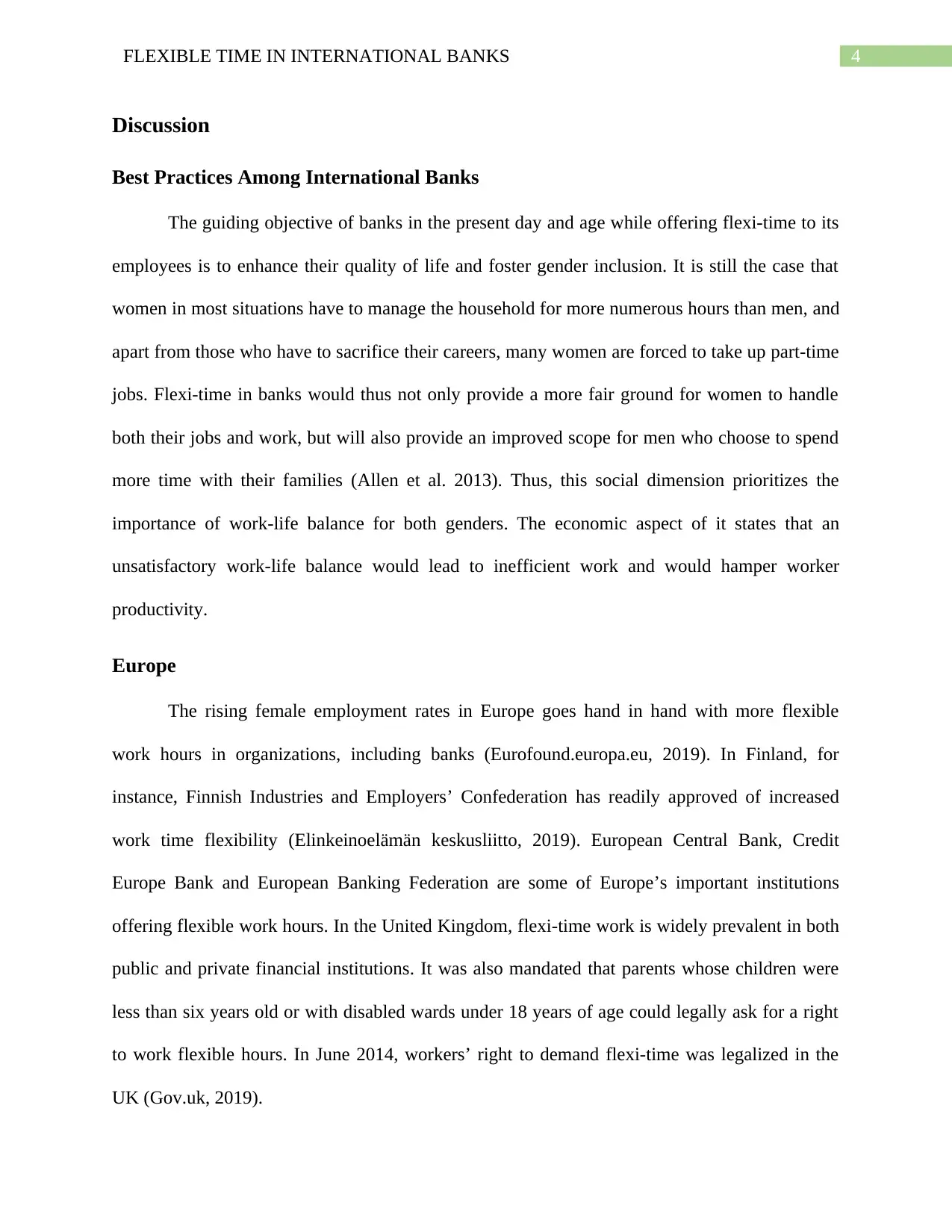
4FLEXIBLE TIME IN INTERNATIONAL BANKS
Discussion
Best Practices Among International Banks
The guiding objective of banks in the present day and age while offering flexi-time to its
employees is to enhance their quality of life and foster gender inclusion. It is still the case that
women in most situations have to manage the household for more numerous hours than men, and
apart from those who have to sacrifice their careers, many women are forced to take up part-time
jobs. Flexi-time in banks would thus not only provide a more fair ground for women to handle
both their jobs and work, but will also provide an improved scope for men who choose to spend
more time with their families (Allen et al. 2013). Thus, this social dimension prioritizes the
importance of work-life balance for both genders. The economic aspect of it states that an
unsatisfactory work-life balance would lead to inefficient work and would hamper worker
productivity.
Europe
The rising female employment rates in Europe goes hand in hand with more flexible
work hours in organizations, including banks (Eurofound.europa.eu, 2019). In Finland, for
instance, Finnish Industries and Employers’ Confederation has readily approved of increased
work time flexibility (Elinkeinoelämän keskusliitto, 2019). European Central Bank, Credit
Europe Bank and European Banking Federation are some of Europe’s important institutions
offering flexible work hours. In the United Kingdom, flexi-time work is widely prevalent in both
public and private financial institutions. It was also mandated that parents whose children were
less than six years old or with disabled wards under 18 years of age could legally ask for a right
to work flexible hours. In June 2014, workers’ right to demand flexi-time was legalized in the
UK (Gov.uk, 2019).
Discussion
Best Practices Among International Banks
The guiding objective of banks in the present day and age while offering flexi-time to its
employees is to enhance their quality of life and foster gender inclusion. It is still the case that
women in most situations have to manage the household for more numerous hours than men, and
apart from those who have to sacrifice their careers, many women are forced to take up part-time
jobs. Flexi-time in banks would thus not only provide a more fair ground for women to handle
both their jobs and work, but will also provide an improved scope for men who choose to spend
more time with their families (Allen et al. 2013). Thus, this social dimension prioritizes the
importance of work-life balance for both genders. The economic aspect of it states that an
unsatisfactory work-life balance would lead to inefficient work and would hamper worker
productivity.
Europe
The rising female employment rates in Europe goes hand in hand with more flexible
work hours in organizations, including banks (Eurofound.europa.eu, 2019). In Finland, for
instance, Finnish Industries and Employers’ Confederation has readily approved of increased
work time flexibility (Elinkeinoelämän keskusliitto, 2019). European Central Bank, Credit
Europe Bank and European Banking Federation are some of Europe’s important institutions
offering flexible work hours. In the United Kingdom, flexi-time work is widely prevalent in both
public and private financial institutions. It was also mandated that parents whose children were
less than six years old or with disabled wards under 18 years of age could legally ask for a right
to work flexible hours. In June 2014, workers’ right to demand flexi-time was legalized in the
UK (Gov.uk, 2019).
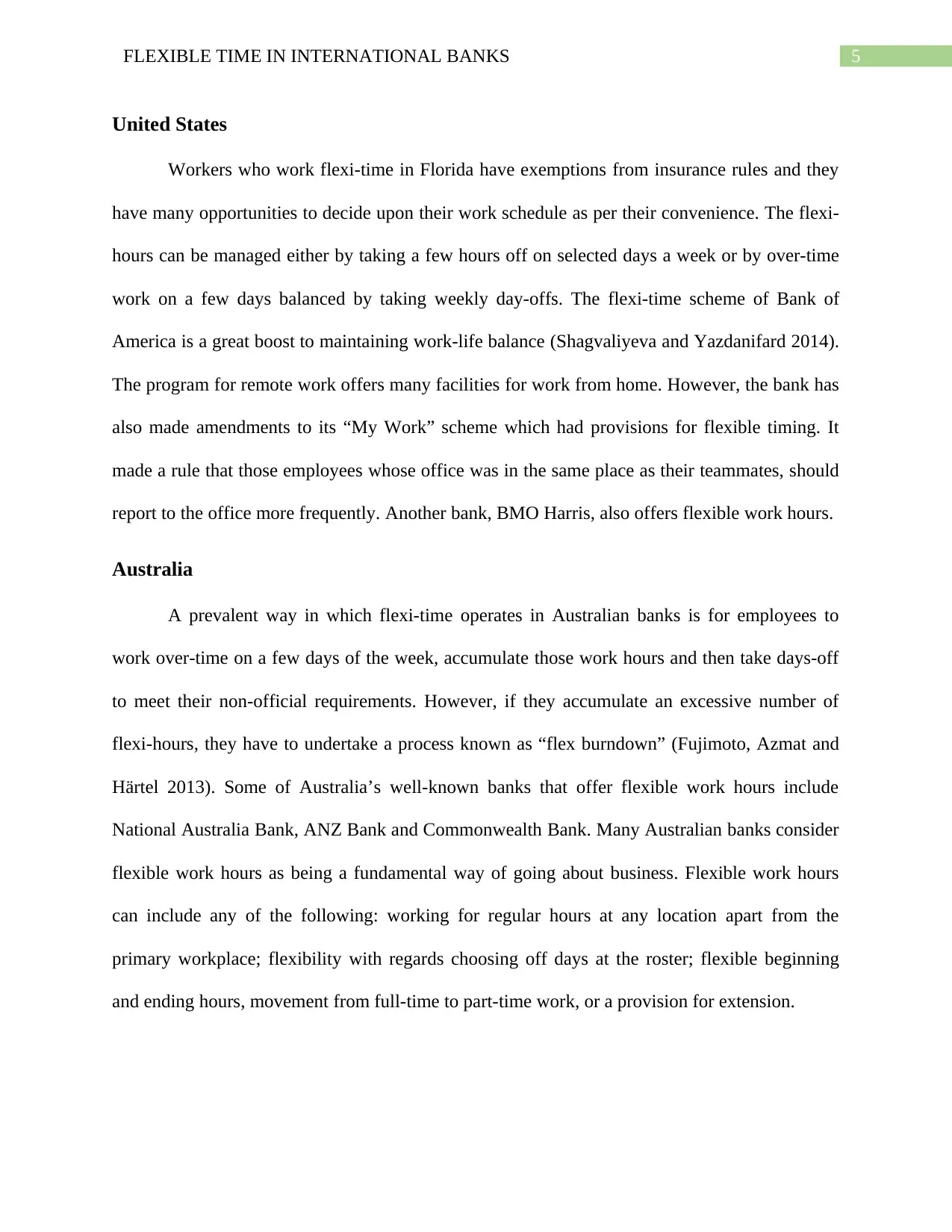
5FLEXIBLE TIME IN INTERNATIONAL BANKS
United States
Workers who work flexi-time in Florida have exemptions from insurance rules and they
have many opportunities to decide upon their work schedule as per their convenience. The flexi-
hours can be managed either by taking a few hours off on selected days a week or by over-time
work on a few days balanced by taking weekly day-offs. The flexi-time scheme of Bank of
America is a great boost to maintaining work-life balance (Shagvaliyeva and Yazdanifard 2014).
The program for remote work offers many facilities for work from home. However, the bank has
also made amendments to its “My Work” scheme which had provisions for flexible timing. It
made a rule that those employees whose office was in the same place as their teammates, should
report to the office more frequently. Another bank, BMO Harris, also offers flexible work hours.
Australia
A prevalent way in which flexi-time operates in Australian banks is for employees to
work over-time on a few days of the week, accumulate those work hours and then take days-off
to meet their non-official requirements. However, if they accumulate an excessive number of
flexi-hours, they have to undertake a process known as “flex burndown” (Fujimoto, Azmat and
Härtel 2013). Some of Australia’s well-known banks that offer flexible work hours include
National Australia Bank, ANZ Bank and Commonwealth Bank. Many Australian banks consider
flexible work hours as being a fundamental way of going about business. Flexible work hours
can include any of the following: working for regular hours at any location apart from the
primary workplace; flexibility with regards choosing off days at the roster; flexible beginning
and ending hours, movement from full-time to part-time work, or a provision for extension.
United States
Workers who work flexi-time in Florida have exemptions from insurance rules and they
have many opportunities to decide upon their work schedule as per their convenience. The flexi-
hours can be managed either by taking a few hours off on selected days a week or by over-time
work on a few days balanced by taking weekly day-offs. The flexi-time scheme of Bank of
America is a great boost to maintaining work-life balance (Shagvaliyeva and Yazdanifard 2014).
The program for remote work offers many facilities for work from home. However, the bank has
also made amendments to its “My Work” scheme which had provisions for flexible timing. It
made a rule that those employees whose office was in the same place as their teammates, should
report to the office more frequently. Another bank, BMO Harris, also offers flexible work hours.
Australia
A prevalent way in which flexi-time operates in Australian banks is for employees to
work over-time on a few days of the week, accumulate those work hours and then take days-off
to meet their non-official requirements. However, if they accumulate an excessive number of
flexi-hours, they have to undertake a process known as “flex burndown” (Fujimoto, Azmat and
Härtel 2013). Some of Australia’s well-known banks that offer flexible work hours include
National Australia Bank, ANZ Bank and Commonwealth Bank. Many Australian banks consider
flexible work hours as being a fundamental way of going about business. Flexible work hours
can include any of the following: working for regular hours at any location apart from the
primary workplace; flexibility with regards choosing off days at the roster; flexible beginning
and ending hours, movement from full-time to part-time work, or a provision for extension.
⊘ This is a preview!⊘
Do you want full access?
Subscribe today to unlock all pages.

Trusted by 1+ million students worldwide
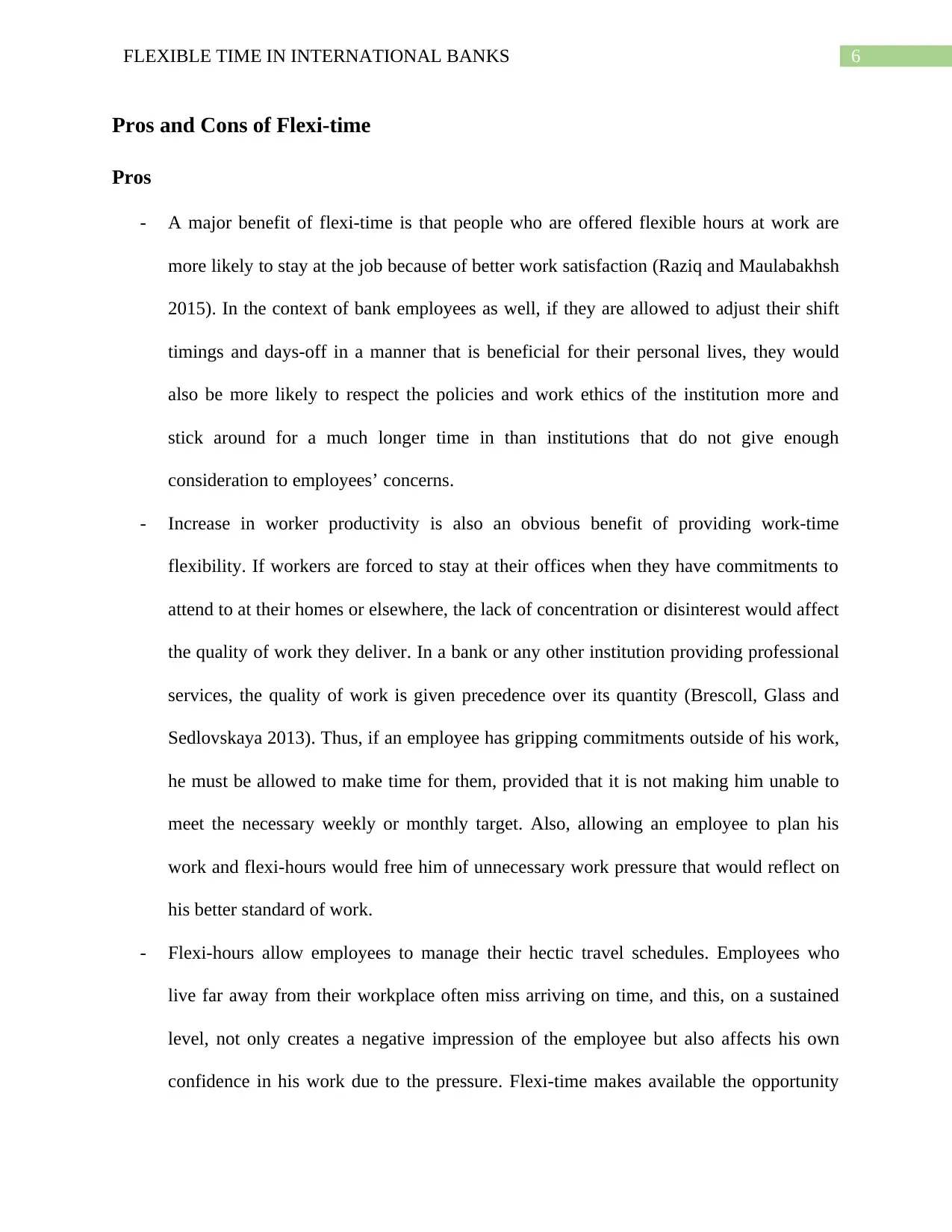
6FLEXIBLE TIME IN INTERNATIONAL BANKS
Pros and Cons of Flexi-time
Pros
- A major benefit of flexi-time is that people who are offered flexible hours at work are
more likely to stay at the job because of better work satisfaction (Raziq and Maulabakhsh
2015). In the context of bank employees as well, if they are allowed to adjust their shift
timings and days-off in a manner that is beneficial for their personal lives, they would
also be more likely to respect the policies and work ethics of the institution more and
stick around for a much longer time in than institutions that do not give enough
consideration to employees’ concerns.
- Increase in worker productivity is also an obvious benefit of providing work-time
flexibility. If workers are forced to stay at their offices when they have commitments to
attend to at their homes or elsewhere, the lack of concentration or disinterest would affect
the quality of work they deliver. In a bank or any other institution providing professional
services, the quality of work is given precedence over its quantity (Brescoll, Glass and
Sedlovskaya 2013). Thus, if an employee has gripping commitments outside of his work,
he must be allowed to make time for them, provided that it is not making him unable to
meet the necessary weekly or monthly target. Also, allowing an employee to plan his
work and flexi-hours would free him of unnecessary work pressure that would reflect on
his better standard of work.
- Flexi-hours allow employees to manage their hectic travel schedules. Employees who
live far away from their workplace often miss arriving on time, and this, on a sustained
level, not only creates a negative impression of the employee but also affects his own
confidence in his work due to the pressure. Flexi-time makes available the opportunity
Pros and Cons of Flexi-time
Pros
- A major benefit of flexi-time is that people who are offered flexible hours at work are
more likely to stay at the job because of better work satisfaction (Raziq and Maulabakhsh
2015). In the context of bank employees as well, if they are allowed to adjust their shift
timings and days-off in a manner that is beneficial for their personal lives, they would
also be more likely to respect the policies and work ethics of the institution more and
stick around for a much longer time in than institutions that do not give enough
consideration to employees’ concerns.
- Increase in worker productivity is also an obvious benefit of providing work-time
flexibility. If workers are forced to stay at their offices when they have commitments to
attend to at their homes or elsewhere, the lack of concentration or disinterest would affect
the quality of work they deliver. In a bank or any other institution providing professional
services, the quality of work is given precedence over its quantity (Brescoll, Glass and
Sedlovskaya 2013). Thus, if an employee has gripping commitments outside of his work,
he must be allowed to make time for them, provided that it is not making him unable to
meet the necessary weekly or monthly target. Also, allowing an employee to plan his
work and flexi-hours would free him of unnecessary work pressure that would reflect on
his better standard of work.
- Flexi-hours allow employees to manage their hectic travel schedules. Employees who
live far away from their workplace often miss arriving on time, and this, on a sustained
level, not only creates a negative impression of the employee but also affects his own
confidence in his work due to the pressure. Flexi-time makes available the opportunity
Paraphrase This Document
Need a fresh take? Get an instant paraphrase of this document with our AI Paraphraser
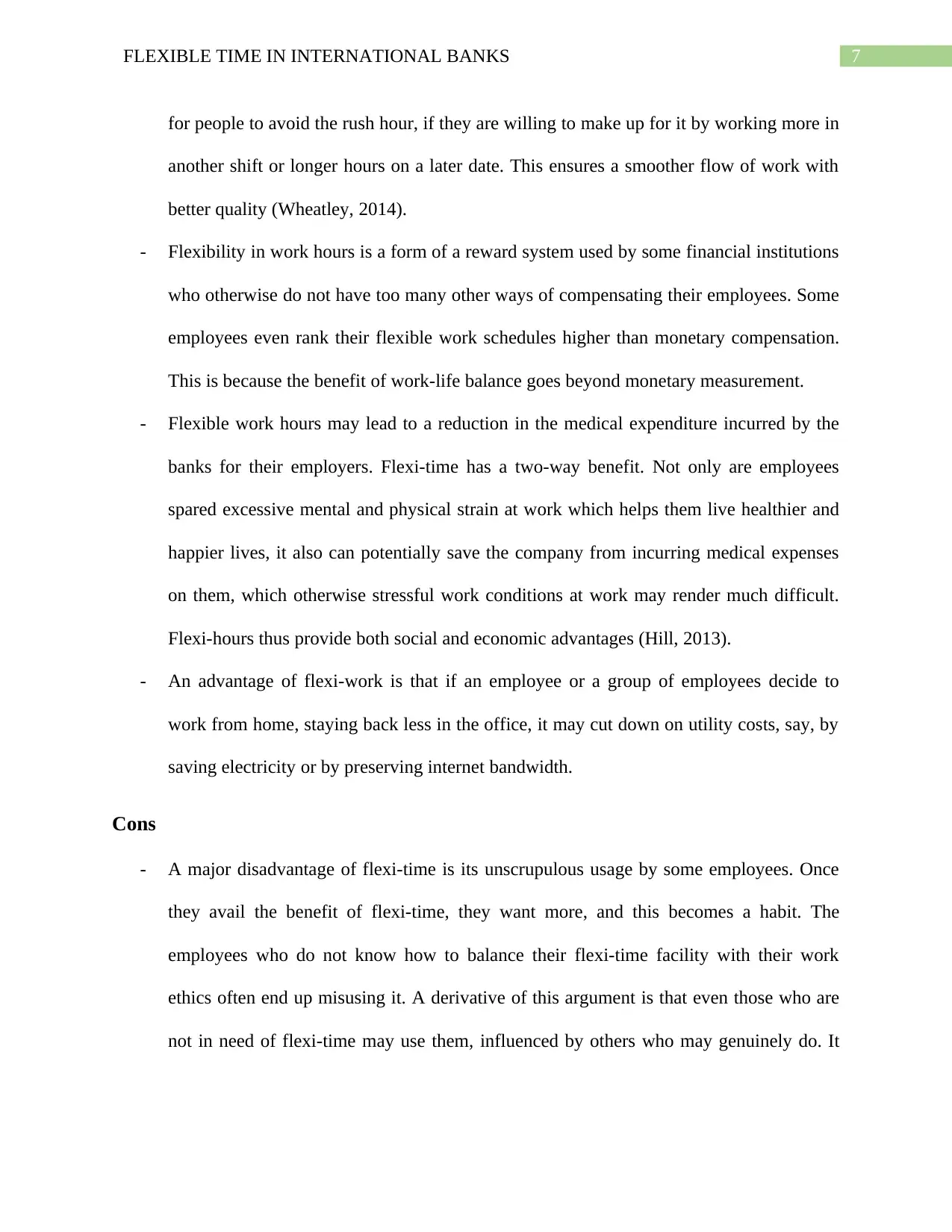
7FLEXIBLE TIME IN INTERNATIONAL BANKS
for people to avoid the rush hour, if they are willing to make up for it by working more in
another shift or longer hours on a later date. This ensures a smoother flow of work with
better quality (Wheatley, 2014).
- Flexibility in work hours is a form of a reward system used by some financial institutions
who otherwise do not have too many other ways of compensating their employees. Some
employees even rank their flexible work schedules higher than monetary compensation.
This is because the benefit of work-life balance goes beyond monetary measurement.
- Flexible work hours may lead to a reduction in the medical expenditure incurred by the
banks for their employers. Flexi-time has a two-way benefit. Not only are employees
spared excessive mental and physical strain at work which helps them live healthier and
happier lives, it also can potentially save the company from incurring medical expenses
on them, which otherwise stressful work conditions at work may render much difficult.
Flexi-hours thus provide both social and economic advantages (Hill, 2013).
- An advantage of flexi-work is that if an employee or a group of employees decide to
work from home, staying back less in the office, it may cut down on utility costs, say, by
saving electricity or by preserving internet bandwidth.
Cons
- A major disadvantage of flexi-time is its unscrupulous usage by some employees. Once
they avail the benefit of flexi-time, they want more, and this becomes a habit. The
employees who do not know how to balance their flexi-time facility with their work
ethics often end up misusing it. A derivative of this argument is that even those who are
not in need of flexi-time may use them, influenced by others who may genuinely do. It
for people to avoid the rush hour, if they are willing to make up for it by working more in
another shift or longer hours on a later date. This ensures a smoother flow of work with
better quality (Wheatley, 2014).
- Flexibility in work hours is a form of a reward system used by some financial institutions
who otherwise do not have too many other ways of compensating their employees. Some
employees even rank their flexible work schedules higher than monetary compensation.
This is because the benefit of work-life balance goes beyond monetary measurement.
- Flexible work hours may lead to a reduction in the medical expenditure incurred by the
banks for their employers. Flexi-time has a two-way benefit. Not only are employees
spared excessive mental and physical strain at work which helps them live healthier and
happier lives, it also can potentially save the company from incurring medical expenses
on them, which otherwise stressful work conditions at work may render much difficult.
Flexi-hours thus provide both social and economic advantages (Hill, 2013).
- An advantage of flexi-work is that if an employee or a group of employees decide to
work from home, staying back less in the office, it may cut down on utility costs, say, by
saving electricity or by preserving internet bandwidth.
Cons
- A major disadvantage of flexi-time is its unscrupulous usage by some employees. Once
they avail the benefit of flexi-time, they want more, and this becomes a habit. The
employees who do not know how to balance their flexi-time facility with their work
ethics often end up misusing it. A derivative of this argument is that even those who are
not in need of flexi-time may use them, influenced by others who may genuinely do. It
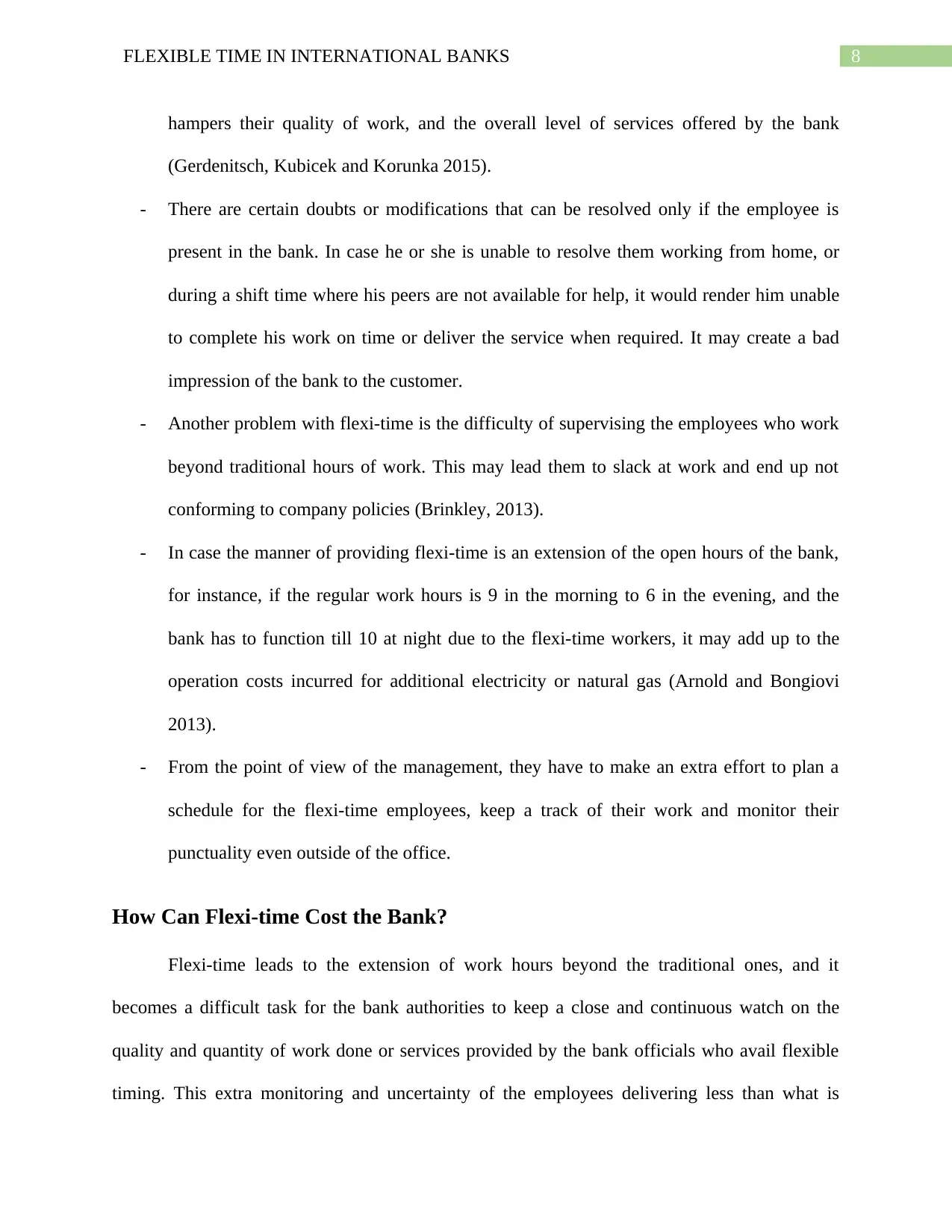
8FLEXIBLE TIME IN INTERNATIONAL BANKS
hampers their quality of work, and the overall level of services offered by the bank
(Gerdenitsch, Kubicek and Korunka 2015).
- There are certain doubts or modifications that can be resolved only if the employee is
present in the bank. In case he or she is unable to resolve them working from home, or
during a shift time where his peers are not available for help, it would render him unable
to complete his work on time or deliver the service when required. It may create a bad
impression of the bank to the customer.
- Another problem with flexi-time is the difficulty of supervising the employees who work
beyond traditional hours of work. This may lead them to slack at work and end up not
conforming to company policies (Brinkley, 2013).
- In case the manner of providing flexi-time is an extension of the open hours of the bank,
for instance, if the regular work hours is 9 in the morning to 6 in the evening, and the
bank has to function till 10 at night due to the flexi-time workers, it may add up to the
operation costs incurred for additional electricity or natural gas (Arnold and Bongiovi
2013).
- From the point of view of the management, they have to make an extra effort to plan a
schedule for the flexi-time employees, keep a track of their work and monitor their
punctuality even outside of the office.
How Can Flexi-time Cost the Bank?
Flexi-time leads to the extension of work hours beyond the traditional ones, and it
becomes a difficult task for the bank authorities to keep a close and continuous watch on the
quality and quantity of work done or services provided by the bank officials who avail flexible
timing. This extra monitoring and uncertainty of the employees delivering less than what is
hampers their quality of work, and the overall level of services offered by the bank
(Gerdenitsch, Kubicek and Korunka 2015).
- There are certain doubts or modifications that can be resolved only if the employee is
present in the bank. In case he or she is unable to resolve them working from home, or
during a shift time where his peers are not available for help, it would render him unable
to complete his work on time or deliver the service when required. It may create a bad
impression of the bank to the customer.
- Another problem with flexi-time is the difficulty of supervising the employees who work
beyond traditional hours of work. This may lead them to slack at work and end up not
conforming to company policies (Brinkley, 2013).
- In case the manner of providing flexi-time is an extension of the open hours of the bank,
for instance, if the regular work hours is 9 in the morning to 6 in the evening, and the
bank has to function till 10 at night due to the flexi-time workers, it may add up to the
operation costs incurred for additional electricity or natural gas (Arnold and Bongiovi
2013).
- From the point of view of the management, they have to make an extra effort to plan a
schedule for the flexi-time employees, keep a track of their work and monitor their
punctuality even outside of the office.
How Can Flexi-time Cost the Bank?
Flexi-time leads to the extension of work hours beyond the traditional ones, and it
becomes a difficult task for the bank authorities to keep a close and continuous watch on the
quality and quantity of work done or services provided by the bank officials who avail flexible
timing. This extra monitoring and uncertainty of the employees delivering less than what is
⊘ This is a preview!⊘
Do you want full access?
Subscribe today to unlock all pages.

Trusted by 1+ million students worldwide
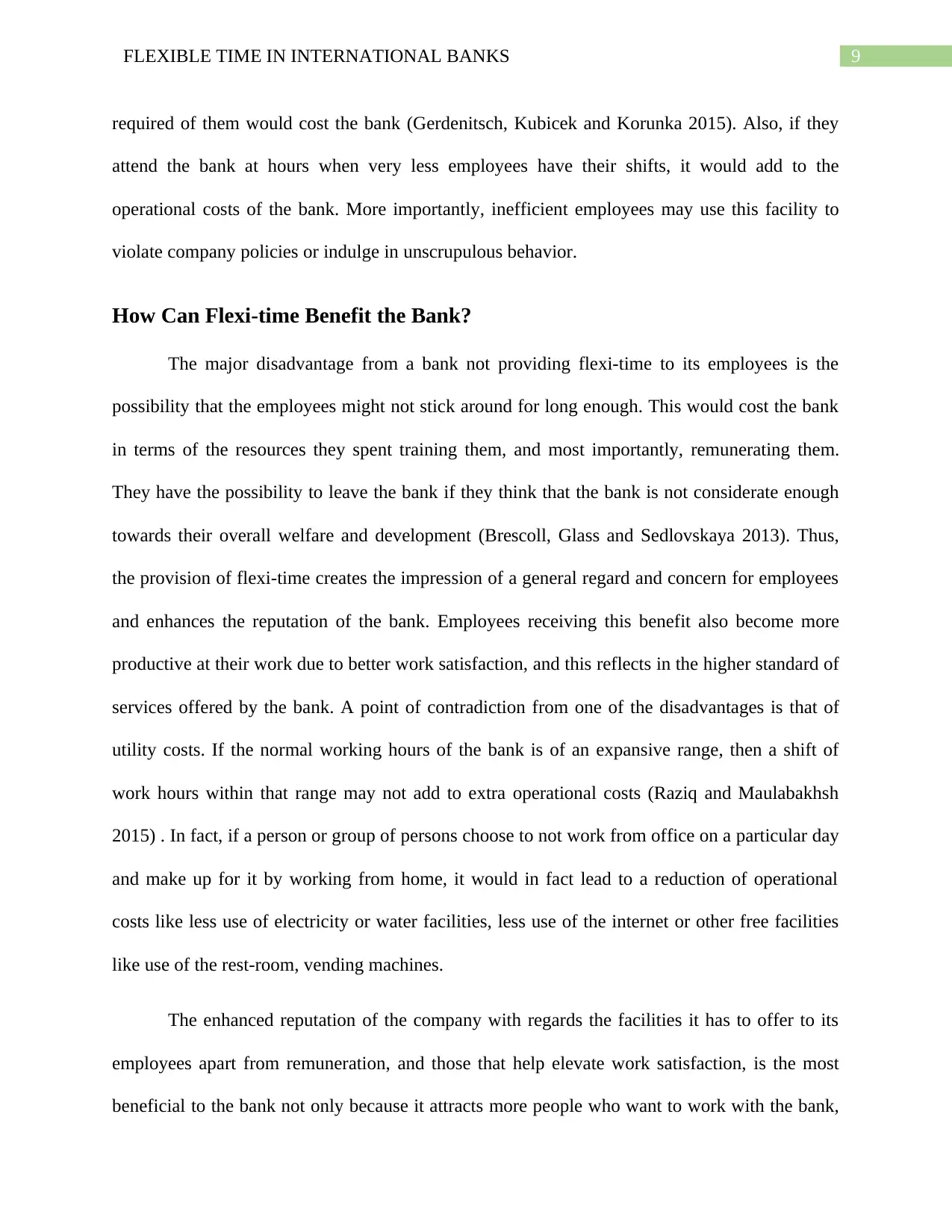
9FLEXIBLE TIME IN INTERNATIONAL BANKS
required of them would cost the bank (Gerdenitsch, Kubicek and Korunka 2015). Also, if they
attend the bank at hours when very less employees have their shifts, it would add to the
operational costs of the bank. More importantly, inefficient employees may use this facility to
violate company policies or indulge in unscrupulous behavior.
How Can Flexi-time Benefit the Bank?
The major disadvantage from a bank not providing flexi-time to its employees is the
possibility that the employees might not stick around for long enough. This would cost the bank
in terms of the resources they spent training them, and most importantly, remunerating them.
They have the possibility to leave the bank if they think that the bank is not considerate enough
towards their overall welfare and development (Brescoll, Glass and Sedlovskaya 2013). Thus,
the provision of flexi-time creates the impression of a general regard and concern for employees
and enhances the reputation of the bank. Employees receiving this benefit also become more
productive at their work due to better work satisfaction, and this reflects in the higher standard of
services offered by the bank. A point of contradiction from one of the disadvantages is that of
utility costs. If the normal working hours of the bank is of an expansive range, then a shift of
work hours within that range may not add to extra operational costs (Raziq and Maulabakhsh
2015) . In fact, if a person or group of persons choose to not work from office on a particular day
and make up for it by working from home, it would in fact lead to a reduction of operational
costs like less use of electricity or water facilities, less use of the internet or other free facilities
like use of the rest-room, vending machines.
The enhanced reputation of the company with regards the facilities it has to offer to its
employees apart from remuneration, and those that help elevate work satisfaction, is the most
beneficial to the bank not only because it attracts more people who want to work with the bank,
required of them would cost the bank (Gerdenitsch, Kubicek and Korunka 2015). Also, if they
attend the bank at hours when very less employees have their shifts, it would add to the
operational costs of the bank. More importantly, inefficient employees may use this facility to
violate company policies or indulge in unscrupulous behavior.
How Can Flexi-time Benefit the Bank?
The major disadvantage from a bank not providing flexi-time to its employees is the
possibility that the employees might not stick around for long enough. This would cost the bank
in terms of the resources they spent training them, and most importantly, remunerating them.
They have the possibility to leave the bank if they think that the bank is not considerate enough
towards their overall welfare and development (Brescoll, Glass and Sedlovskaya 2013). Thus,
the provision of flexi-time creates the impression of a general regard and concern for employees
and enhances the reputation of the bank. Employees receiving this benefit also become more
productive at their work due to better work satisfaction, and this reflects in the higher standard of
services offered by the bank. A point of contradiction from one of the disadvantages is that of
utility costs. If the normal working hours of the bank is of an expansive range, then a shift of
work hours within that range may not add to extra operational costs (Raziq and Maulabakhsh
2015) . In fact, if a person or group of persons choose to not work from office on a particular day
and make up for it by working from home, it would in fact lead to a reduction of operational
costs like less use of electricity or water facilities, less use of the internet or other free facilities
like use of the rest-room, vending machines.
The enhanced reputation of the company with regards the facilities it has to offer to its
employees apart from remuneration, and those that help elevate work satisfaction, is the most
beneficial to the bank not only because it attracts more people who want to work with the bank,
Paraphrase This Document
Need a fresh take? Get an instant paraphrase of this document with our AI Paraphraser
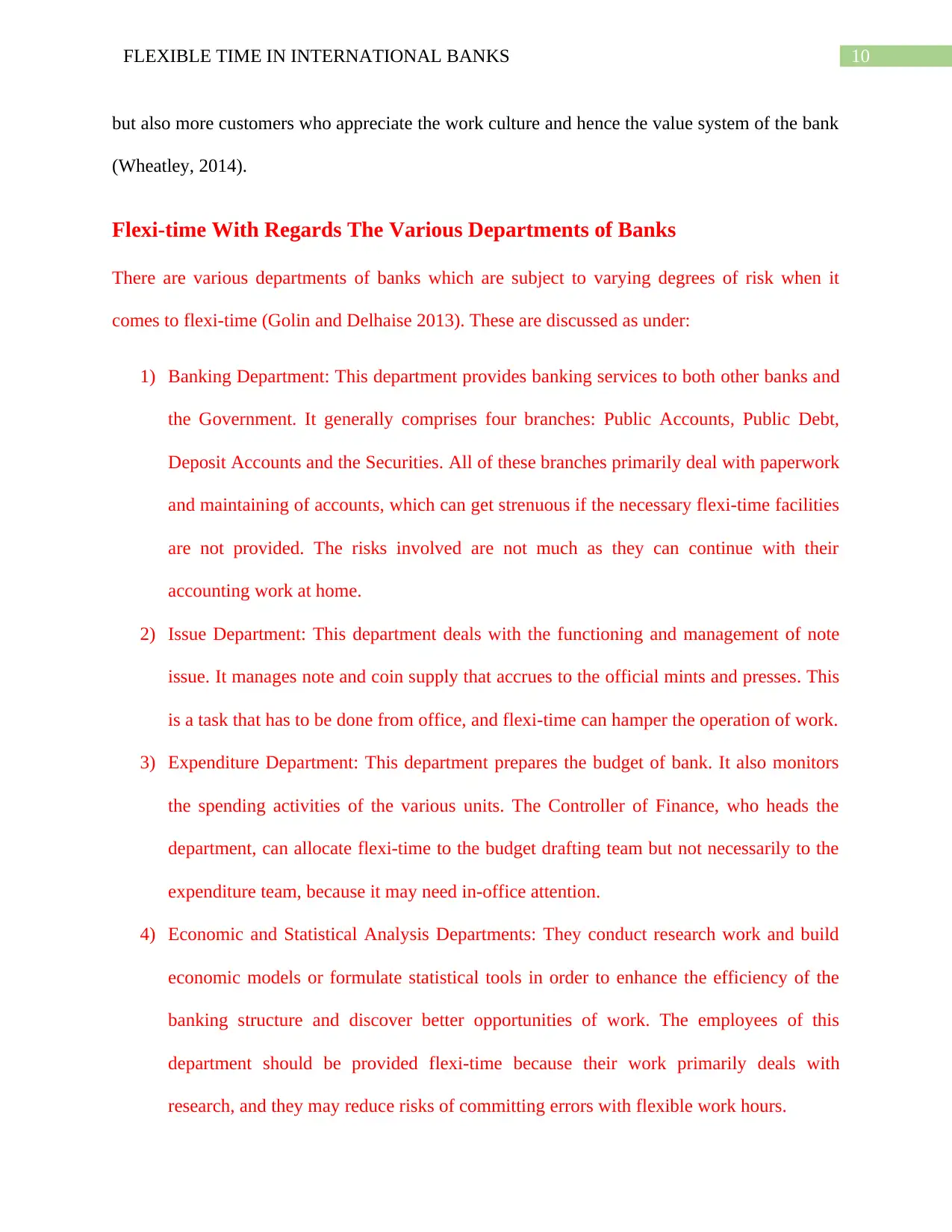
10FLEXIBLE TIME IN INTERNATIONAL BANKS
but also more customers who appreciate the work culture and hence the value system of the bank
(Wheatley, 2014).
Flexi-time With Regards The Various Departments of Banks
There are various departments of banks which are subject to varying degrees of risk when it
comes to flexi-time (Golin and Delhaise 2013). These are discussed as under:
1) Banking Department: This department provides banking services to both other banks and
the Government. It generally comprises four branches: Public Accounts, Public Debt,
Deposit Accounts and the Securities. All of these branches primarily deal with paperwork
and maintaining of accounts, which can get strenuous if the necessary flexi-time facilities
are not provided. The risks involved are not much as they can continue with their
accounting work at home.
2) Issue Department: This department deals with the functioning and management of note
issue. It manages note and coin supply that accrues to the official mints and presses. This
is a task that has to be done from office, and flexi-time can hamper the operation of work.
3) Expenditure Department: This department prepares the budget of bank. It also monitors
the spending activities of the various units. The Controller of Finance, who heads the
department, can allocate flexi-time to the budget drafting team but not necessarily to the
expenditure team, because it may need in-office attention.
4) Economic and Statistical Analysis Departments: They conduct research work and build
economic models or formulate statistical tools in order to enhance the efficiency of the
banking structure and discover better opportunities of work. The employees of this
department should be provided flexi-time because their work primarily deals with
research, and they may reduce risks of committing errors with flexible work hours.
but also more customers who appreciate the work culture and hence the value system of the bank
(Wheatley, 2014).
Flexi-time With Regards The Various Departments of Banks
There are various departments of banks which are subject to varying degrees of risk when it
comes to flexi-time (Golin and Delhaise 2013). These are discussed as under:
1) Banking Department: This department provides banking services to both other banks and
the Government. It generally comprises four branches: Public Accounts, Public Debt,
Deposit Accounts and the Securities. All of these branches primarily deal with paperwork
and maintaining of accounts, which can get strenuous if the necessary flexi-time facilities
are not provided. The risks involved are not much as they can continue with their
accounting work at home.
2) Issue Department: This department deals with the functioning and management of note
issue. It manages note and coin supply that accrues to the official mints and presses. This
is a task that has to be done from office, and flexi-time can hamper the operation of work.
3) Expenditure Department: This department prepares the budget of bank. It also monitors
the spending activities of the various units. The Controller of Finance, who heads the
department, can allocate flexi-time to the budget drafting team but not necessarily to the
expenditure team, because it may need in-office attention.
4) Economic and Statistical Analysis Departments: They conduct research work and build
economic models or formulate statistical tools in order to enhance the efficiency of the
banking structure and discover better opportunities of work. The employees of this
department should be provided flexi-time because their work primarily deals with
research, and they may reduce risks of committing errors with flexible work hours.
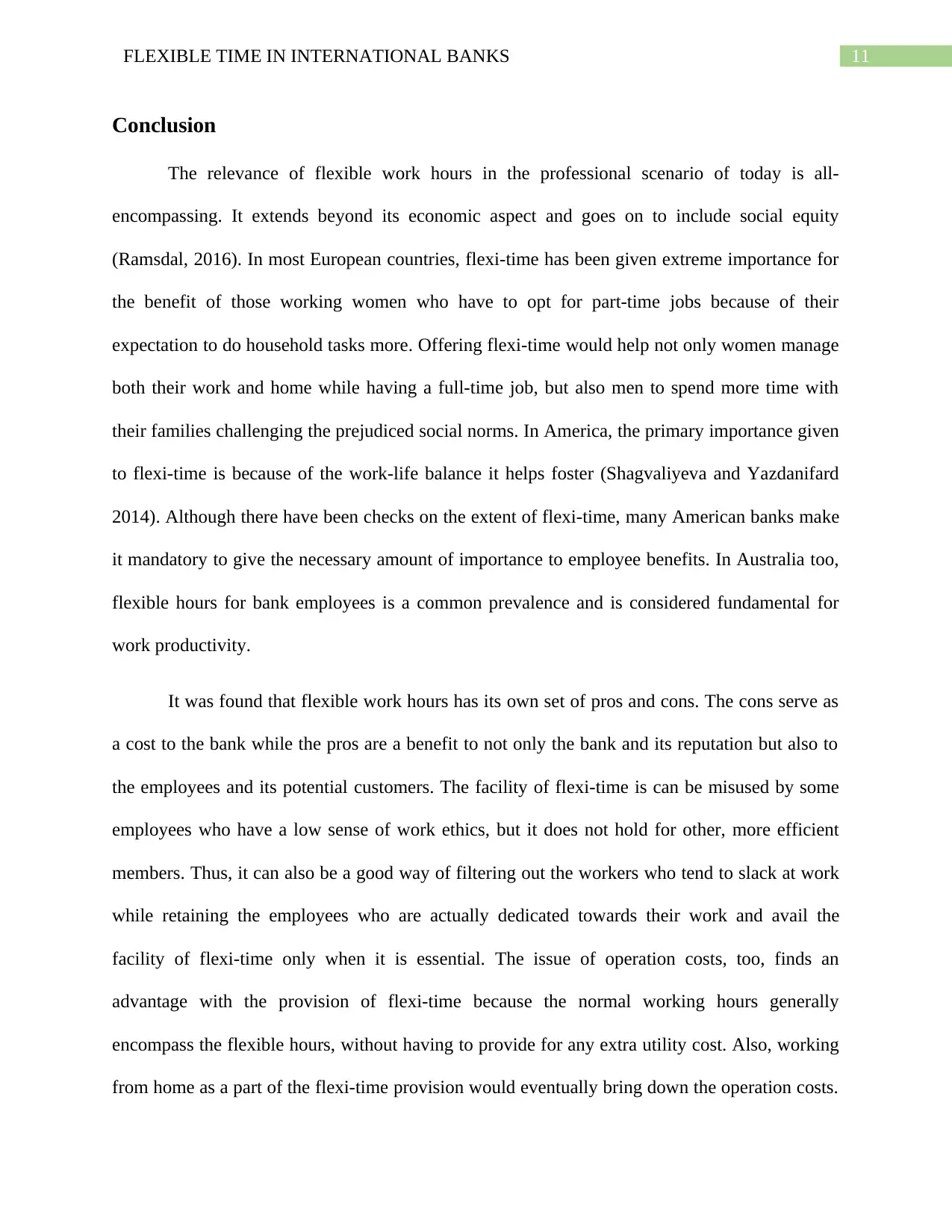
11FLEXIBLE TIME IN INTERNATIONAL BANKS
Conclusion
The relevance of flexible work hours in the professional scenario of today is all-
encompassing. It extends beyond its economic aspect and goes on to include social equity
(Ramsdal, 2016). In most European countries, flexi-time has been given extreme importance for
the benefit of those working women who have to opt for part-time jobs because of their
expectation to do household tasks more. Offering flexi-time would help not only women manage
both their work and home while having a full-time job, but also men to spend more time with
their families challenging the prejudiced social norms. In America, the primary importance given
to flexi-time is because of the work-life balance it helps foster (Shagvaliyeva and Yazdanifard
2014). Although there have been checks on the extent of flexi-time, many American banks make
it mandatory to give the necessary amount of importance to employee benefits. In Australia too,
flexible hours for bank employees is a common prevalence and is considered fundamental for
work productivity.
It was found that flexible work hours has its own set of pros and cons. The cons serve as
a cost to the bank while the pros are a benefit to not only the bank and its reputation but also to
the employees and its potential customers. The facility of flexi-time is can be misused by some
employees who have a low sense of work ethics, but it does not hold for other, more efficient
members. Thus, it can also be a good way of filtering out the workers who tend to slack at work
while retaining the employees who are actually dedicated towards their work and avail the
facility of flexi-time only when it is essential. The issue of operation costs, too, finds an
advantage with the provision of flexi-time because the normal working hours generally
encompass the flexible hours, without having to provide for any extra utility cost. Also, working
from home as a part of the flexi-time provision would eventually bring down the operation costs.
Conclusion
The relevance of flexible work hours in the professional scenario of today is all-
encompassing. It extends beyond its economic aspect and goes on to include social equity
(Ramsdal, 2016). In most European countries, flexi-time has been given extreme importance for
the benefit of those working women who have to opt for part-time jobs because of their
expectation to do household tasks more. Offering flexi-time would help not only women manage
both their work and home while having a full-time job, but also men to spend more time with
their families challenging the prejudiced social norms. In America, the primary importance given
to flexi-time is because of the work-life balance it helps foster (Shagvaliyeva and Yazdanifard
2014). Although there have been checks on the extent of flexi-time, many American banks make
it mandatory to give the necessary amount of importance to employee benefits. In Australia too,
flexible hours for bank employees is a common prevalence and is considered fundamental for
work productivity.
It was found that flexible work hours has its own set of pros and cons. The cons serve as
a cost to the bank while the pros are a benefit to not only the bank and its reputation but also to
the employees and its potential customers. The facility of flexi-time is can be misused by some
employees who have a low sense of work ethics, but it does not hold for other, more efficient
members. Thus, it can also be a good way of filtering out the workers who tend to slack at work
while retaining the employees who are actually dedicated towards their work and avail the
facility of flexi-time only when it is essential. The issue of operation costs, too, finds an
advantage with the provision of flexi-time because the normal working hours generally
encompass the flexible hours, without having to provide for any extra utility cost. Also, working
from home as a part of the flexi-time provision would eventually bring down the operation costs.
⊘ This is a preview!⊘
Do you want full access?
Subscribe today to unlock all pages.

Trusted by 1+ million students worldwide
1 out of 16
Related Documents
Your All-in-One AI-Powered Toolkit for Academic Success.
+13062052269
info@desklib.com
Available 24*7 on WhatsApp / Email
![[object Object]](/_next/static/media/star-bottom.7253800d.svg)
Unlock your academic potential
Copyright © 2020–2025 A2Z Services. All Rights Reserved. Developed and managed by ZUCOL.





